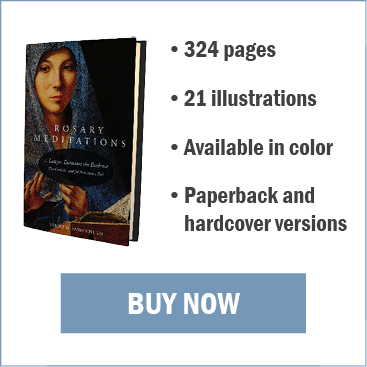The following explanation of the Luminous Mysteries is taken from the October 16, 2002 apostolic letter The Rosary of the Virgin Mary (Rosarium Virginis Mariae) by Pope John Paul II.
THE LUMINOUS MYSTERIES
Moving on from the infancy and hidden life in Nazareth to the public life of Jesus, our contemplation brings us to those mysteries which may be called in a special way “mysteries of light.” Certainly, the whole mystery of Christ is a mystery of light. He is the “light of the world” (Jn 8:12). Yet this truth emerges in a special way during the years of his public life, when he proclaims the Gospel of the Kingdom. In proposing to the Christian community five significant moments—“luminous” mysteries—during this phase of Christ’s life, I think that the following can be fittingly singled out: (1) his Baptism in the Jordan, (2) his self-manifestation at the wedding of Cana, (3) his proclamation of the Kingdom of God, with his call to conversion, (4) his Transfiguration, and finally, (5) his institution of the Eucharist, as the sacramental expression of the Paschal Mystery.
Each of these mysteries is a revelation of the Kingdom now present in the very person of Jesus. The Baptism in the Jordan is first of all a mystery of light. Here, as Christ descends into the waters, the innocent one who became “sin” for our sake (cf. 2 Cor 5:21), the heavens open wide and the voice of the Father declares him the beloved Son (cf. Mt 3:17 and parallels), while the Spirit descends on him to invest him with the mission which he is to carry out. Another mystery of light is the first of the signs, given at Cana (cf. Jn 2:1–12), when Christ changes water into wine and opens the hearts of the disciples to faith, thanks to the intervention of Mary, the first among believers. Another mystery of light is the preaching by which Jesus proclaims the coming of the Kingdom of God, calls to conversion (cf. Mk 1:15) and forgives the sins of all who draw near to him in humble trust (cf. Mk 2:3–13, Lk 7:47–48): the inauguration of that ministry of mercy which he continues to exercise until the end of the world, particularly through the Sacrament of Reconciliation which he has entrusted to his Church (cf. Jn 20:22-23). The mystery of light par excellence is the Transfiguration, traditionally believed to have taken place on Mount Tabor. The glory of the Godhead shines forth from the face of Christ as the Father commands the astonished Apostles to “listen to him (cf. Lk 9:35 and parallels) and to prepare to experience with him the agony of the Passion, so as to come with him to the joy of the Resurrection and a life transfigured by the Holy Spirit. A final mystery of light is the institution of the Eucharist, in which Christ offers his body and blood as food under the signs of bread and wine, and testifies “to the end” his love for humanity (Jn 13:1), for whose salvation he will offer himself in sacrifice.
In these mysteries, apart from the miracle at Cana, the presence of Mary remains in the background. The Gospels make only the briefest reference to her occasional presence at one moment or other during the preaching of Jesus (cf. Mk 3:31-35; Jn 2:12), and they give no indication that she was present at the Last Supper and the institution of the Eucharist. Yet the role she assumed at Cana in some way accompanies Christ throughout this ministry. The revelation made directly by the Father at the Baptism in the Jordan and echoed by John the Baptist is placed on Mary’s lips at Cana, and it becomes the great maternal counsel which Mary addresses to the Church of every age: “Do whatever he tells you” (Jn 2:25). This counsel is a fitting introduction to the words and signs of Christ’s public ministry ad it forms the Marian foundation of all the “mysteries of light.”
Prayed on: Thursdays
The Baptism
And when Jesus was baptized, he went up immediately from the water, and behold, the heavens were opened and he saw the Spirit of God descending like a dove, and alighting on him; and behold, a voice from heaven, saying, “This is my beloved Son, with whom I am well pleased.”
Matthew 3:16–17
Fruit of the Mystery: Openness to the Holy Spirit
The Wedding at Cana
His mother said to the servants, “Do whatever he tells you.” Now six stone jars were standing there, for the Jewish rites of purification, each holding twenty or thirty gallons. Jesus said to them, “Fill the jars with water.” And they filled them up to the brim.
John 2:5–7
Fruit of the Mystery: To Jesus through Mary
The Proclamation of the Gospel
“And preach as you go, saying, ‘The kingdom of heaven is at hand.’ Heal the sick, raise the dead, cleanse lepers, cast out demons. You received without pay, give without pay.”
Matthew 10:7–8
Fruit of the Mystery: Repentance and Trust in God
The Transfiguration
And as he was praying, the appearance of his countenance was altered, and his clothing become dazzling white.
Luke 9:29
Fruit of the Mystery: Desire for Holiness
Institution of the Eucharist
And he took bread, and when he had given thanks he broke it and gave it to them, saying, “This is my body which is given for you. Do this in remembrance of me.” And likewise the chalice after supper, saying, “This chalice which is poured out for you is the new covenant in my blood.”
Luke 22:19–20
Fruit of the Mystery: Adoration
